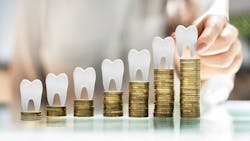"Through the roof": The impact of rising costs on dentistry
The ADA Health Policy Institute (HPI) released new data showing sharp increases in the costs of operating dental practices, while insurance reimbursements remained flat—or even decreased.
- Roughly 1 in 4 have seen the costs of supplies and materials increase by at least 20%
- 47% of dentists reported that lab fees increased more than 1-10%
- 44% of dentists reported staff wages had increased by more than 1-10%
- 1 in 4 dentists reported that their insurance reimbursements decreased
DentistryIQ reached out to Chelsea Fosse, DMD, MPH, Senior Health Policy Analyst, HPI, for a deeper look into this data and what the ADA is hoping to do for dentists.
Why recent reporting on the cost of dentistry isn’t quite what it seems
In July 2022, the US Bureau of Labor Statistics released a Consumer Price Index (CPI) report showing a sharp increase in the cost of dental services. For example, noted CNBC, “Medical-care costs climbed 0.7% on the month, propelled by a 1.9% increase in dental services, the largest monthly rise ever recorded for that sector in data that goes back to 1995.”
But the HPI team suspected these numbers weren’t really telling the full story, Fosse says. “There was an increase in the dental CPI, but when you really looked at that year over year instead of just in the past month, the dental CPI increases were lower than the all-items CPI. It wasn't as drastic as maybe some of the announcements around that time made it seem.”
“Despite all of that, our team really wanted to understand what could be behind any increase in the dental services CPI,” she says. “So we started thinking, okay, what are those practice operating costs that go that could be eventually reflected in that dental CPI?”
To help quantify how cost increases could be affecting dental practices, the HPI added questions about costs to its August polling questions, and will continue to follow these numbers in the coming months.
Dentistry is a high-overhead industry, with some estimating that the median dental practice overhead is 75% of collections. This makes practices vulnerable to prices increases, especially when they come across the board.
How the ADA HPI hopes dentists can leverage this information
“The most notable item from the August polling that we are trying to shout from a mountaintop is this idea that, very clearly, practice operating costs are going up—in some cases through the roof. And yet the insurance companies aren’t really responsive to that,” says Fosse.
As for how dentists can best leverage this information, she says that the upshot is “just to be communicative with your in-network payers. Talk to the reps at your insurance companies and share this information. Flag when your contract might be up so that you can get ahead of it and start thinking about what your demands will be to continue a contract with some of your insurers.”
“We have relationships with some of the dental insurers and share this information with them, too,” Fosse continues. “But of course, it really all comes down to a dentist or a practice's individual agreements with these companies. Make sure that they know about the increased financial stress that that that dentists are under.”
What’s keeping practices from maintaining full schedules
For the past 6 months, dental practices have been steadily booked around 85% to 86%. When practices were asked which factors were preventing them from having a full schedule, last-minute cancellations ranked first:
- Patient no-shows and cancellation with fewer than 24 hours of notice (82%)
- Patient cancellations greater than 24 hours (38%)
- Not enough patients making appointments (41%)
- Trouble filling vacant staff positions (37%)
- COVID safety protocols (14%)
Low patient demand and staffing difficulties were also challenging for about 4 out of 10 dentists. The report indicated that assistants were the most in-demand, but dental hygienists were proving the most challenging to hire.
The ADA recently began segmenting out the reasons for patient cancellations, says Fosse, so the HPI is not sure how the current cancellation rates compare to those of the past. Since the issue is clearly a huge challenge for practices right now, the ADA plans to continue following it.
Dentists’ confidence in the US economy increased in August 2022
Many dentists are still not confident in the recovery of their practices or the overall dental sector. Only 57% of dentists were “very” or “somewhat” confident of the recovery of their practice within the next six months. Confidence in the US economy as a whole has declined since early this year, and with it, confidence in the dental sector and individual practices has also dipped.
However, confidence in the US economy rose from 18% to 26% in August 2022. Fosse says they don’t know the exact reason why dentists are feeling more optimistic, but noted that consumers were more optimistic in August, according to a Gallup poll. However, at the time of this article, American stock markets tumbled in response to newly released inflation data.
Note: An earlier version of this story incorrectly stated the increase in staff wages and lab fees. DentistryIQ regrets the error.
Resources for staffing issues
What is quiet quitting, and why should it concern your dental office?
Strategies for navigating the dental industry labor shortage
About the Author
Amelia Williamson DeStefano
Group Editorial Director
Amelia Williamson DeStefano, MA, is group editorial director of the Endeavor Business Media Dental Group, where she leads the publication of high-quality content that empowers oral-health professionals to advance patient well-being, succeed in business, and cultivate professional joy and fulfillment. She holds a master's in English Literature from the University of Tulsa and has worked in dental media since 2015.
Updated May 16, 2023

